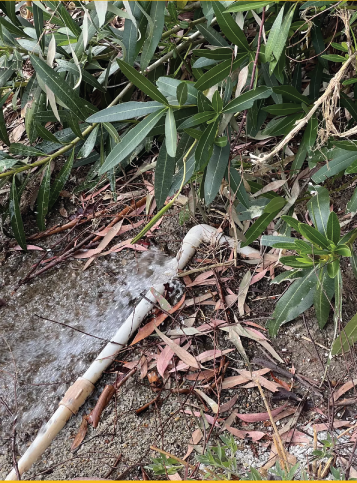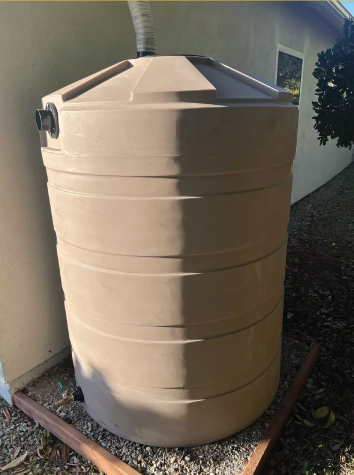The expense hiding in your garden

A typical smart irrigation controller will have the capability to adjust for the weather. (Kobi Bardugo)
As water rates continue to rise and supply concerns linger, these 7 tactics can help trim your monthly bill
Irrigation, by definition, is to “supply land with water” from the Latin word irrigatus.
As you are probably aware, water rates in San Diego went up by 5 percent in December 2023, followed by another 4 percent increase on Jan. 1 With the scarcity of water increasing, rates will likely continue to rise. Following are seven actions the home gardener can take to reduce their water use and water bill.
What services does your water bill cover? Approximately 59 percent of the public utilities fiscal year 2024 budget is expected to go toward the purchase of imported water. The remaining 41 percent is for upgrades, maintenance and debt service for the city’s water system, such as on the ongoing project of replacing 40 miles of pipelines each year to reduce pipeline failures.
How to reduce your water bill? Here are seven options to consider, depending on your current water consumption, available time and money:
1) Start with leak detection, which can be tricky. Begin by checking your water bill. If you see a major consumption increase and you aren’t hosting your in-laws again, you may have a leak. Then check for a wet spot, leaking pipe or broken sprinkler. It can be time-consuming, but the effort quickly results in a lower water bill. Once you find the leak, consider hiring a professional landscaper or, if you are fixing it yourself, attend a workshop provided by the city or an online credible resource.

Leaks are a primary reason water goes to waste. Check irrigation to ensure that it is operating correctly. (Kobi Bardugo)
2) Update your irrigation timer to a Wi-Fi smart irrigation controller. The smart controller receives live information from a local weather station and will water your landscape with the needed amount of water, including stopping watering on rainy days. Cities or counties may offer rebates for purchasing a smart controller.
3) Add one or more rain barrels. The San Diego region receives an average of 12 inches of rain per year, which does not meet the needs of this metropolitan area. Much of this rain is run-off that goes to the ocean. To help keep that rainwater on your property, install a rain barrel. Rain barrels redirect the rain that falls on your roof, via the gutters, into a storage container which you can redirect into your landscape when and where it is needed.
4) Apply mulch (wood chips, gravel, bark, etc.) on top of your garden’s soil. This cost-effective step will reduce evaporation and therefore retain water in the soil for the plant’s use. Mulch will also reduce weed growth, making less work for the home gardener, and will help ensure you’re irrigating your plants and trees and not weeds.
5) Update your irrigation system. Save water by either changing traditional rotor irrigation heads to MP rotator heads or converting it to drip irrigation. Both are highly efficient methods of watering plants by delivering precise amounts of water directly to plants, minimizing water wastage and maximizing plant growth. With drip irrigation, water is distributed through a network of tubes, pipes and emitters placed near the base of plants. With MP rotator heads water is distributed in a finer spray more evenly for better coverage and absorption.
6) Consider the removal of your lawn, partially or entirely. It can offer numerous benefits both for the environment and homeowners. Key advantages of lawn removal include:
a. Water conservation: Lawns typically require significant amounts of water to maintain their lush appearance, especially in regions with hot and dry climates. By removing all or part of a lawn, homeowners can significantly reduce their water consumption, contributing to water conservation efforts and lowering water bills.
b. Reduced chemical usage: Many homeowners use pesticides, herbicides, and synthetic fertilizers to maintain their lawns, which can have detrimental effects on the environment and human health. Removing a lawn eliminates the need for these chemical inputs, leading to a healthier and more sustainable landscape.
c. Lower maintenance requirements: Maintaining a lawn requires regular mowing, edging, and fertilizing, which can be time-consuming and labor-intensive. By replacing a lawn with low-maintenance landscaping options such as native plants, ground covers, or hardscape features, homeowners can reduce the time and effort spent on yard maintenance.

Rain barrels come in a variety of sizes to fit a homeowner’s needs and available space. This one is 420 gallons and one (or a couple chained) will capture hundreds of gallons of water to use in the garden. (Kobi Bardugo)
7) Re-landscape your turf with low-water-use plants. There are many options. Consider using natives, which are naturally adapted to our region. When properly installed, they require less water, fertilizer, and maintenance compared to non-native plants, making them well-suited for landscaping projects. While they use less water, they will need supplemental irrigation the first few years after planting in order to get established in the landscape. To emulate nature, overhead irrigation is recommended.
Taking the above steps will help you reduce water usage and its subsequent cost.
Kobi Bardugo is a UCCE Master Gardener and a San Diego licensed landscaping contractor with a degree in environmental science and botany. Kobi’s top favorite plant is Nelumbonucifera, also known as the sacred lotus.

